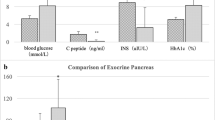Abstract
The aim of the study was the assessment of the concentrations and establishment of mutual relationships between three main protease inhibitors: alpha-1-antitrypsin (AAT), alpha-2-macroglobulin (α-2-M) and antithrombin-III (AT-III), and of the total trypsin inhibitory capacity (TIC) in the serum of diabetic and non-diabetic children during adolescence. Forty-nine children (24 girls and 25 boys) with type 1 diabetes mellitus and 24 non-diabetic children (13 girls and 11 boys) were divided according to the Tanner scale into three groups: pre-, peri- and post-pubertal. The concentrations of AAT, α-2-M and AT-III were determined by the radial immunodiffusion method on NOR-Partigen plates (Dade-Behring), while TIC was determined by the method using BAPNA as substrate. Means and medians of serum AAT [1.55 g/l, 1.40 (95% confidence interval, 1.42–1.68), respectively] and TIC [10.6 mg trypsin/100 ml, 10.3 (95% CI, 9.5–11.7)] in diabetic children were lower than means and medians of AAT [1.81 g/l, 1.60 (95% CI 1.55–2.07), respectively] and TIC [12.5 mg trypsin/100 ml, 13.2 (95% CI, 10.9–14.1)] in non-diabetic children. A comparison of variables between Tanner groups shows an increasing trend of AAT concentration in diabetic children and a decreasing trend of TIC in non-diabetic subjects. In contrast to pre- and peri-puberty, no correlations were found in the postpubertal period between the studied parameters, either in diabetic or non-diabetic patients. Hyperglycaemia and the duration of diabetes were found to have a significant association with α-2-M and AT-III concentrations, but not with AAT serum concentrations. The concentrations and correlations between serum protease inhibitors in diabetic children during adolescence are disrupted compared with non-diabetic children. Taking into account the unfavourable consequences of vascular complications resulting from serum trypsin inhibitor changes and protease– antiprotease imbalance, diabetic children are at greater risk of this occurring during adolescence.
Similar content being viewed by others
Author information
Authors and Affiliations
Corresponding author
Rights and permissions
About this article
Cite this article
Lisowska-Myjak, B., Pachecka, J., Kaczyńska, B. et al. Serum protease inhibitor concentrations and total antitrypsin activity in diabetic and non-diabetic children during adolescence. Acta Diabetol 43, 88–92 (2006). https://doi.org/10.1007/s00592-006-0220-8
Received:
Accepted:
Issue Date:
DOI: https://doi.org/10.1007/s00592-006-0220-8




